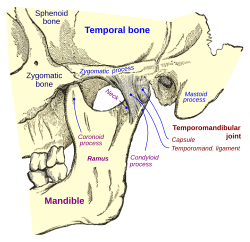|
Temporomandibular ligament
The temporomandibular ligament, also known as the external lateral ligament, is a ligament that connects the lower articular tubercle of the zygomatic arch to the lateral and posterior border of the neck of the mandible. It prevents posterior displacement of the mandible. It also prevents the condyloid process from being driven upward by a blow to the jaw, which would otherwise fracture the base of the skull. StructureThe temporomandibular ligament originates from the lower articular tubercle of the zygomatic arch.[1] This usually has a rough surface for the ligament to attach to.[1] It attaches to the lateral and posterior border of the neck of the mandible.[1] It consists of two short, narrow fasciculi, one in front of the other. It is broader above than below, and its fibers are directed obliquely downward and backward.[1] It is covered by the parotid gland, and by the integument. FunctionThe temporomandibular ligament constrains the mandible as it opens, keeping the condyloid process close to the joint.[2] It prevents posterior displacement of the mandible. It also prevents the condyloid process from being driven upward by a blow to the jaw, which would otherwise fracture the base of the skull. References
Saladin, Kenneth S. (2005) Human Anatomy. New York, NY: McGraw-Hill. ISBN 0-07-039080-0
|
||||||||||||||||||||||||
